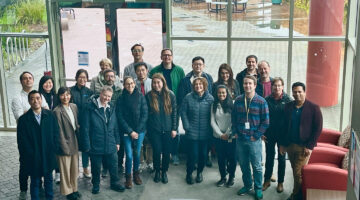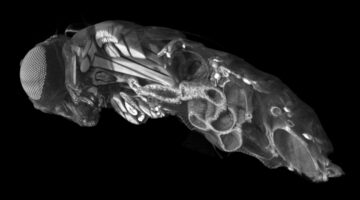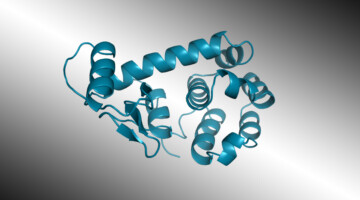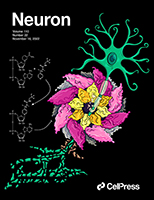A collaboration between Berkeley Lab and Genentech, a member of the Roche Group, is working to break through some of the drug delivery bottlenecks by designing the most effective lipid nanoparticles (LNPs)—tiny spherical pouches made of fatty molecules that encapsulate therapeutic agents until they dock with cell membranes and release their contents. Read more »
Allosteric Tuning of Caspase-7: Establishing the Nexus of Structure and Catalytic Power
How can allosteric sites be more effectively targeted by small-molecule drugs? Using an integrated in vitro/in silico experimental workflow; we discovered novel allosteric inhibitors of caspase-7 and revealed new connections between the active site and the remote allosteric site (i. e., allosteric structure–activity relationships, ASARs) for this valuable disease target. Read more »
A Molecular-Scale Understanding of Misorientation Toughening in Corals and Seashells
Researchers reveal that the toughness of polycrystalline seashells and coral skeletons is increased by small misorientation of adjacent crystals. The findings pave the way toward bioinspired materials with tunable toughness. Read more »
In Fruit-Fly Gut, Bacterial Niche Gets Remodeled for New Arrivals
Researchers found that fruit flies have a specialized niche in their digestive tracts that selects, maintains, and controls bacteria that benefit the fly. Colonization by one type of bacteria physically remodels the niche, promoting secondary colonization by unrelated bacteria. The results will help dissect the mechanisms of host-microbe symbiosis. Read more »
Plant Enzyme Builds Polymers That Fortify Cell Walls
With data obtained at the ALS, researchers gained insight into how an enzyme orchestrates the synthesis of a pectin polymer that imparts strength and flexibility to plant cell walls. The work could lead to improved biofuel production and guide the design of polymers with tailored functionalities for industrial or biomedical applications. Read more »![]()
![]()
Gemini Beamline 2.0.1 Banks Its First Protein Structure
A protein structure obtained from ALS Beamline 2.0.1 (“Gemini”) has recently been published in the literature and deposited into the Protein Data Bank (PDB)—two significant firsts for this beamline. The structure helped provide new insights into the molecular mechanisms involved in triggering certain inflammatory diseases. Read more »
Chatbot-Style AI Designs Novel Functional Protein
Researchers used an artificial intelligence (AI) algorithm, similar to those used in natural-language (“chatbot”) models, to design a functional protein that was then structurally validated at the ALS. The work could speed the development of novel proteins for almost anything from therapeutics to degrading plastic. Read more »![]()
![]()
Structural Investigation of Therapeutic Antibodies Using Hydroxyl Radical Protein Footprinting Methods
Well-known high-resolution structural methods are often used to characterize antibody structures, but many require specialized sample preparation that may perturb antibody structure. We describe here the relatively new method of hydroxyl radical protein footprinting, a solution-state method that can provide structural and kinetic information on antibodies or antibody–antigen interactions useful for therapeutic antibody design. Read more »
Surface Charge and Nanoparticle Chromophore Coupling to Achieve Fast Exciton Quenching and Efficient Charge Separation in Photoacoustic Imaging (PAI) and Photothermal therapy (PTT)
Organic semiconductor nanoparticles (OSNs) convert absorbed light into heat, and are commonly used in photothermal therapy and photoacoustic imaging. Here, the OAN, Y6, is shown to form strong intermolecular packing, manipulated by surface charge under restrained sizes, yielding new pi-pi stacking and fast exciton quenching. The temperature of the tumor area can rise to more than 70 degrees under NIR irradiation, which can effectively ablate a tumor. Read more »
Uncompetitive, adduct-forming SARM1 inhibitors are neuroprotective in preclinical models of nerve injury and disease
Researchers describe potent small-molecule inhibitors that are neuroprotective in preclinical models of nerve injury and disease. The cover depicts the destruction of an axon by the enzyme SARM1, shown disproportionately large to convey its catastrophic role in driving degeneration once it is activated upon injury. Read more »
- « Previous Page
- 1
- 2
- 3
- 4
- 5
- 6
- …
- 24
- Next Page »









